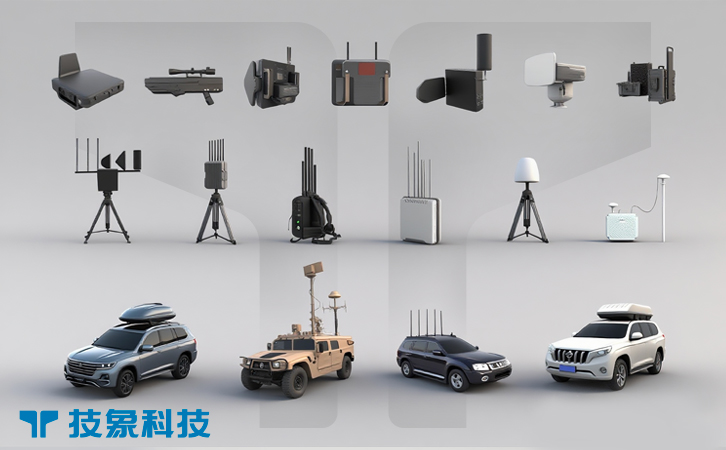The drone proliferation in 2025, with over 6 million unmanned aerial vehicles (UAVs) in global use, has expanded threats across large areas, as rogue drones coordinate or evade centralized defenses in urban sprawls or remote regions. Anti-drone mesh networks, consisting of interconnected nodes (sensors, jammers, and relays) that form a self-healing, distributed system, have become a resilient counter-UAV technology. These networks use wireless links to share data and coordinate responses, providing wide-area coverage for borders, cities, or military zones without single points of failure. Unlike fixed installations or single sensors, mesh networks adapt to node losses and scale dynamically, making them ideal for expansive or contested environments. This article explores the wide-area drone threat, the mechanics of mesh networks, their real-world applications, and the challenges and future potential of this distributed counter-drone solution.
I. The Wide-Area Drone Threat and Need for Mesh Networks
Rogue drones operate over vast areas, coordinating attacks or surveillance beyond single-system reach, with over 2,500 incidents in 2024, including swarm incursions across borders or urban grids, causing widespread disruptions and losses in the millions. In military contexts like Ukraine, drones cover large zones for reconnaissance, while civilian risks include distributed smuggling or monitoring networks exploiting terrain to avoid detection.
Centralized systems fail in expansive or disrupted areas, vulnerable to jamming or damage. Anti-drone mesh networks address this by distributing nodes for redundant coverage, enabling collective defense. Their role is essential for scalable protection, as seen in 2025 European border pilots where meshes tracked and neutralized drones over 50 km. The DEFENSE Act, enacted in September 2025, supports distributed tech for civilian infrastructure, emphasizing mesh networks’ importance in countering wide-area drone operations through resilient, collaborative surveillance.
II. Mechanics of Anti-Drone Mesh Networks
Anti-drone mesh networks link nodes—each with sensors (radar, RF, acoustic) and effectors (jammers, cameras)—via wireless protocols like Zigbee or LoRa for low-power communication. Nodes self-organize into a topology, sharing data to form a unified airspace map, with AI routing information around failures. Systems like those from Persistent Systems or custom DoD meshes use edge computing for local decisions, escalating to central hubs.
The mechanics involve node deployment (ground, pole, or drone-mounted), automatic linking, and AI-driven fusion for threat detection—RF nodes spot signals, radar tracks positions, triggering coordinated jammers. For example, a mesh can isolate a drone by surrounding it with nodes for multi-angle disruption. Advantages include fault tolerance, scalability (hundreds of nodes), and cost-efficiency ($1,000 per node). Limitations include bandwidth constraints in dense meshes and vulnerability to cyber attacks. In 2025, advancements in 5G mesh integration and AI optimization have boosted efficiency, making networks a key component of distributed C-UAS strategies.
III. Applications and Real-World Deployments
Mesh networks are deployed for wide-area defense, offering collaborative protection. In civilian applications, cities like Singapore use urban meshes to monitor airspaces, detecting and jamming drones over districts, preventing disruptions in 2025 trials. Borders employ node chains for continuous coverage, as in U.S.-Mexico pilots tracking smuggling UAVs across deserts.
In military applications, meshes secure forward zones. The U.S. Army’s 2025 exercises in Europe used distributed nodes to counter swarm incursions, relaying data for coordinated strikes. Naval meshes protect fleets, integrating ship and buoy nodes for maritime defense. The Counter UAS Technology USA Conference in December 2025 showcased these, emphasizing solar-powered nodes for remote areas. Success relies on node density and secure links, but meshes’ distribution makes them indispensable for expansive threats.
IV. Challenges and Future Prospects
Mesh networks face deployment, security, and scalability challenges. Initial setup requires node placement, vulnerable to sabotage, while cyber threats can compromise links, needing encryption. Costs accumulate with node numbers, starting at $10,000 for small meshes.
Regulatory hurdles include FCC spectrum allocation for links, though the September 2025 DEFENSE Act streamlines for security. Ethical concerns involve widespread surveillance, mandating data privacy under ITU guidelines. Future prospects are strong, with 2025 innovations in self-healing AI and satellite-hybrid meshes. By 2030, the counter-UAS market grows, with meshes leading for coverage. Policy support ensures ethical use, positioning anti-drone mesh networks as a foundation of distributed aerial defense.
Conclusion
Anti-drone mesh networks deliver resilient, wide-area protection against rogue UAVs, coordinating nodes for comprehensive defense in 2025’s expansive threats. Their distributed design makes them ideal for cities, borders, and military zones, complementing centralized C-UAS tools. Despite challenges like security and costs, real-world successes and emerging innovations highlight their potential. As drone threats spread, mesh networks—supported by reforms—will remain vital in layered defenses. By overcoming hurdles, stakeholders can deploy this technology to secure vast airspaces, ensuring connectivity and safety in a drone-dominated world.



